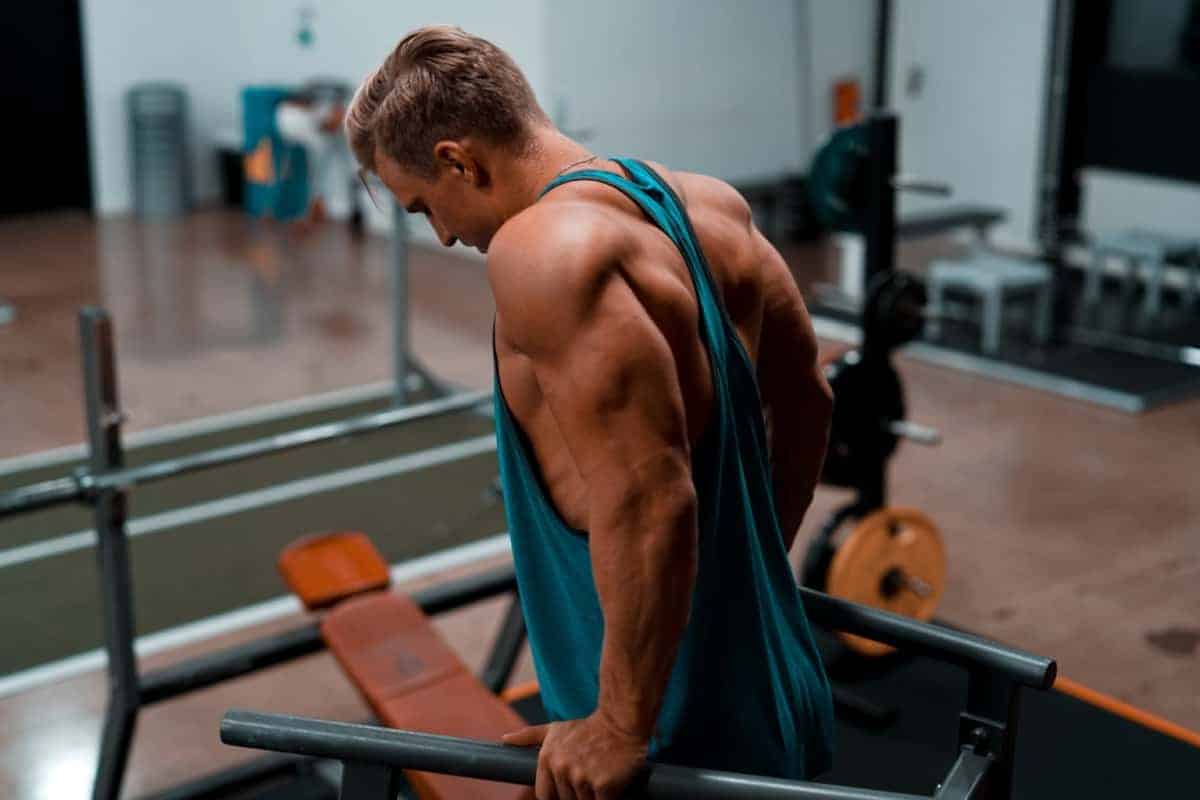In this article we do not simply list the best triceps exercises. We group them into 4 groups according to the stimuli they produce on the triceps in general and on its 3 heads in particular.
For this it is important that you understand the anatomy of the triceps brachii and its biomechanics, and so, when you see different triceps exercises on the internet, in the gym or if you train triceps in calisthenics, you will be able to distinguish which exercise it is and what it is used for.
Triceps brachii anatomy
The triceps brachii is a large, thick muscle that occupies the entire posterior aspect of the upper arm, between the elbow and shoulder (image 1). It often appears in a horseshoe shape on the posterior aspect of the upper arm (Tiwana & Bordoni, 2020).
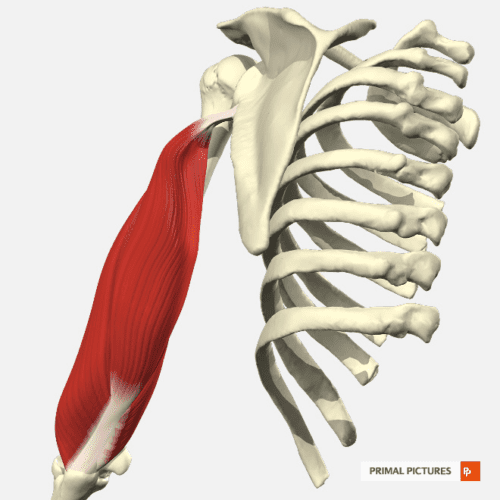
.
It is composed of 3 heads, hence its name (tri = three; ceps = heads).
From the outer part of the arm towards the inner part we find the lateral (external) head, long head and medial head (image 2).
The lateral head and long head are larger and largely hide the medial head.
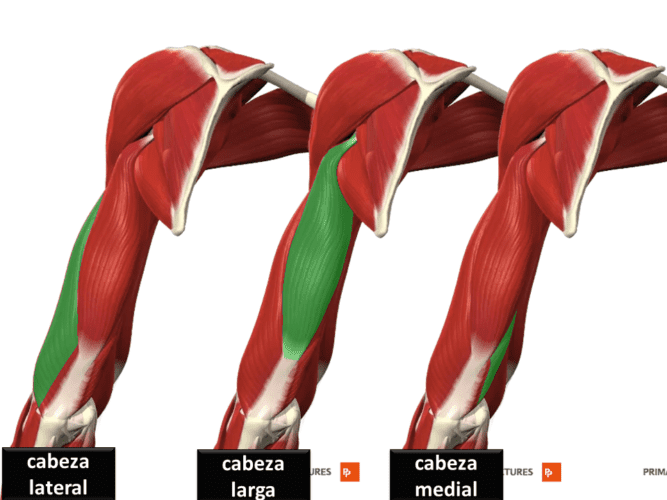
.
We will talk in depth about each of these and how to increase the emphasis on each, although they cannot be separated and will all be activated together.
Origin and insertion of the triceps brachii
Best triceps exercises should be selected to stimulate all 3 heads of the triceps. To do this, it is necessary to know where each of these heads originate and insert.
The lateral head (image 3), the long head (image 4) and the medial head (image 5) originate in different places.
All three heads insert into the olecranon (the bony prominence of the elbow).
The long and lateral head converge on a tendon, while the medial head attaches to the olecranon through a deeper and initially separate tendon (Madsen et al., 2006).
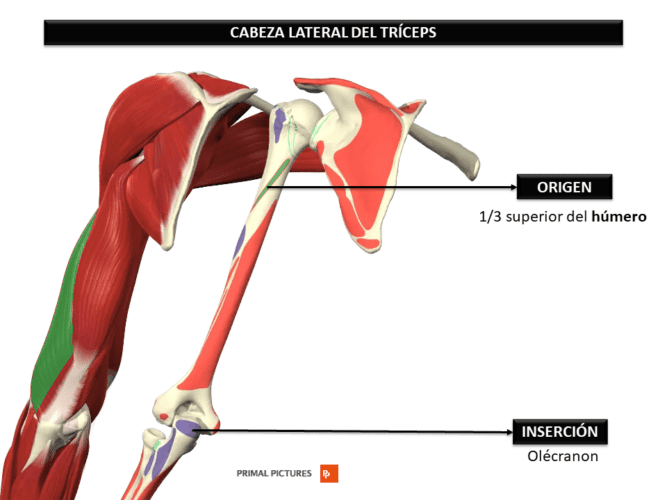
.
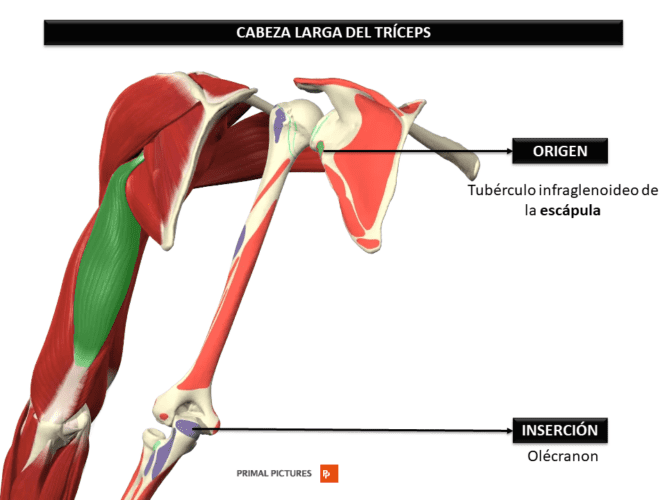
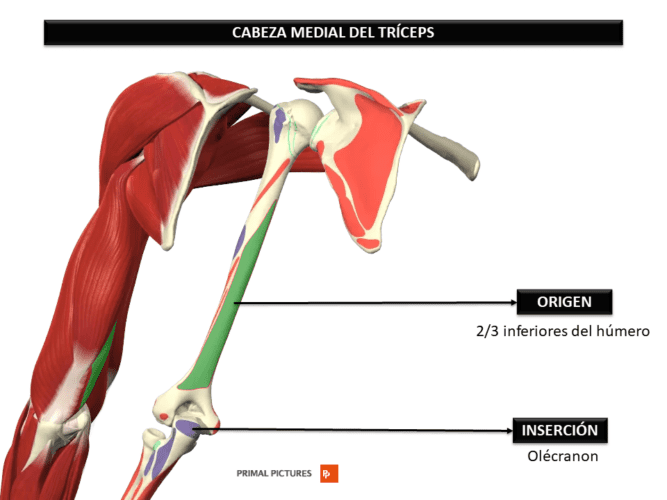
One detail that is vital in best triceps exercise selection is that the lateral head and medial head are monoarticular (act only the elbow), while the long head is bi-articular (acts on elbow and shoulder).
We will see below why this detail is so important.
Function of the triceps
The three heads perform forearm extension at the elbow joint (image 6). They also stabilize the elbow when the forearm and hand perform fine movements such as writing (Tiwana & Bordoni, 2020).
The long head, in addition, produces weak shoulder extension and assists in stabilizing the shoulder joint.
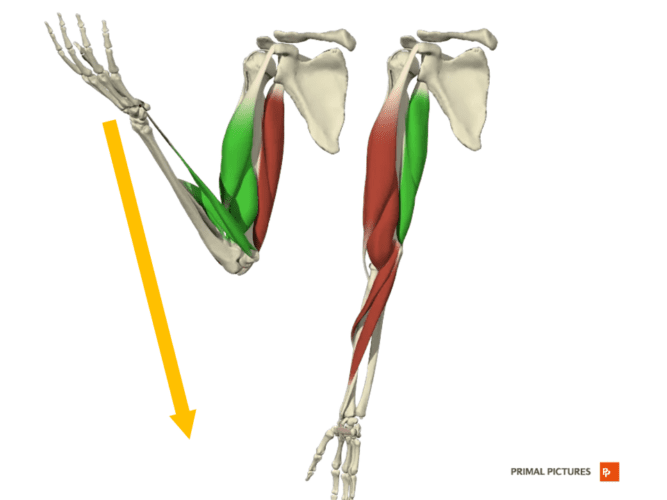
.
Although the function is the same, the three heads do not function in unison during elbow extension (Hussain, Sundaraj, Subramaniam, & Lam, 2020).
They depend on the degree of shoulder flexion.
En este curso vamos a tratar el entrenamiento de la fuerza orientada a la hipertrofia muscular, buscando las formas de optimizar el proceso a la hora de planificar las cargas y las sesiones de entrenamiento.
Aprenderemos a determinar cuándo nos interesa conseguir esa hipertrofia, cómo esta afecta a los niveles de fuerza y la importancia de conocer el estado inicial de la persona que se someta a este tipo de entrenamiento.
Triceps heads activation according to the degrees of shoulder flexion.
Activation of the biarticular head of the triceps(long head) is affected by elbow and shoulder position, whereas the other heads(lateral and medial) only depend on elbow angulation (Davidson & Rice, 2010).
There are therefore different levels of activation of each of the heads depending on the shoulder flexion angles (Davidson & Rice, 2010).
As the activity of the long head varies, and as each of the three heads is dependent on the behavior of the other two, the activation and strength of the lateral and medial head is also mediated by shoulder flexion.
Image 7 (Kholinne et al., 2018) shows an elbow extension in 5 different shoulder positions.
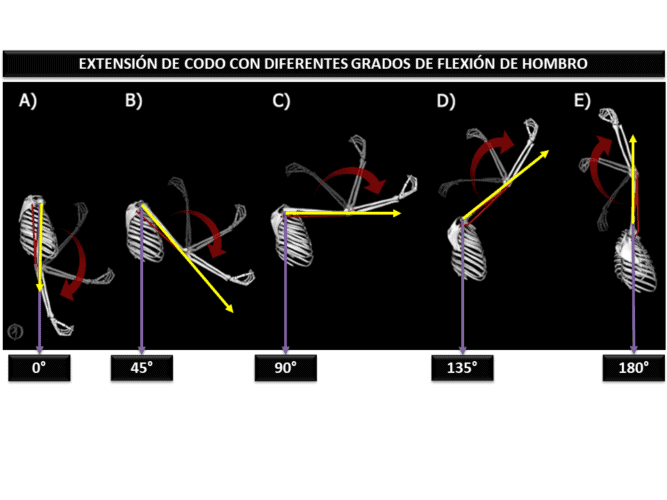
.
This image is important since we will use it as a guide to elaborate the 4 sets of best triceps exercises based on shoulder position:
- Group 1. Full shoulder flexion. 180° shoulder flexion (E): arms positioned overhead or slightly below.
- Group 2. Partial shoulder flexion. 90° of shoulder flexion (C): arms extended perpendicular to the body, up to 135° (D).
- Group 3. No shoulder flexion. 0° shoulder flexion (A): elbows glued to the sides up to 45° (B).
- Group 4. Slight shoulder extension. Less than 0° of shoulder flexion (not shown in the image, these would be negative degrees). Arms behind the body.
Aspects to take into account in best triceps exercises
In all the best triceps exercises that you can find in this article, or anywhere else, you must take into account the following aspects.
The triceps exercises we present here with free weights, pulley or elastic bands, in all their variations, can also be performed on the machines designed for this purpose.
In our training program we should include triceps exercises that have different movement and activation patterns.
All triceps exercises may look the same to you, and they are. Elbow extension occurs in all of them.
What changes is the position of the shoulder relative to the trunk, whether we flex the elbow more or less, the grip we use and the force vector.
Therefore, varying our posture is a simple and effective way to stimulate different muscle regions.
Shoulder position
We have already commented that the lateral and medial heads only depend on the elbow, but as the activation of the long head also depends on the shoulder, everything is modified with that shoulder position.
Long head
As the shoulder flexes, the long head stretches (Landin & Thompson, 2011), finding long head at its maximum stretch point with full shoulder flexion.
With 0° of flexion or with slight shoulder extension (arms behind the body), the opposite occurs , the long head shortens further.
Lateral head and medial head
The elongation and contraction of the lateral and medial head, being monoarticular (depending only on elbow flexion and extension) will not be greater or lesser with a different shoulder position.
But depending on the participation of the long head, they will be activated to a greater or lesser extent, and therefore, indirectly, they also depend on the position of the shoulder.
Elbow position
Below we analyze the muscle activations in triceps exercises according to the position of the elbow.
Long head and lateral head
They produce a relatively constant activation throughout the elbow extension (Murray, Buchanan, & Delp, 2000).
Medial head
At 0° of elbow extension its activity is lower than the other heads, so it participates more at the onset of contraction (Landin & Thompson, 2011; Madsen et al., 2006).
It requires a greater degree of elbow flexion for optimal stretching (Madsen et al., 2006). This is why it works primarily when the elbow is highly flexed and less so when it is extended.
Fatigue
Next we analyze fatigue in the triceps heads.
Long head and lateral head
The long head, along with the lateral head, begin to perform to a greater extent but fatigue earlier than the medial head (Ali et al., 2015, 2014).
Medial head
The medial head is involved in all types of elbow extensions, while the lateral and long heads participate in elbow extension with some resistance (Landin, Thompson, & Jackson, 2018).
This is why the medial head takes longer to fatigue than the lateral and long heads (Ali et al., 2015, 2014) having to take this into account if we are looking for muscle mass gain.
Going very close to failure to take advantage of this activation of the medial head with a fatigue of the lateral and long heads.
Type of grip
Let’s look at the types of grip.
Neutral grip
The palms of the hands face each other. The activation of the 3 heads is balanced.
Prone grip
The position of the hand when looking at the wrist watch. It favors the lateral head.
Supine grip
The opposite position to the previous one. Slightly favors the medial head.
Grip width
In all best triceps exercises we should choose a biacromial (shoulder width) width.
If we spread our hands further apart, the activation of the biceps brachii decreases.
Elbows
The elbows should always remain static during triceps exercises, without opening or pointing outward during triceps exercises.
We must contract the triceps to the maximum at the end of the movement, but without locking the elbows.
Wrist
Always remain in a neutral position in all triceps exercises. No flexion or extension.
Triceps exercises
Below we see best triceps exercises with emphasis on:
Long head
It is advisable to train it at higher stretch points that add more effort than without it (Alves et al., 2018).
- Group 1: Triceps exercises with full shoulder flexion: Position E) in image 7 is the one that places the most emphasis on the long head.
- Group 2: Triceps exercises with partial shoulder flexion: Positions D) and C) in image 7 also place emphasis on the long head, although slightly less.
Lateral and medial head
The medial and lateral head cannot be isolated from each other, but we can leave the long head slightly out of play, so that these heads act more.
- Group 3: Triceps exercises without shoulder flexion to emphasize lateral (mainly) and medial head.
- Group 4: Triceps exercises with slight shoulder extension to emphasize medial (mainly) and lateral head.
View this post on Instagram
Group 1: Triceps exercises with full shoulder flexion
- Shoulder flexion to 180° and close.
- In this position the long head is at maximum stretch and has a greater range of motion.
- Emphasis on the long head.
Triceps overhead extensions
Several best triceps exercises that provide a similar stimulus are shown in Figure 8.
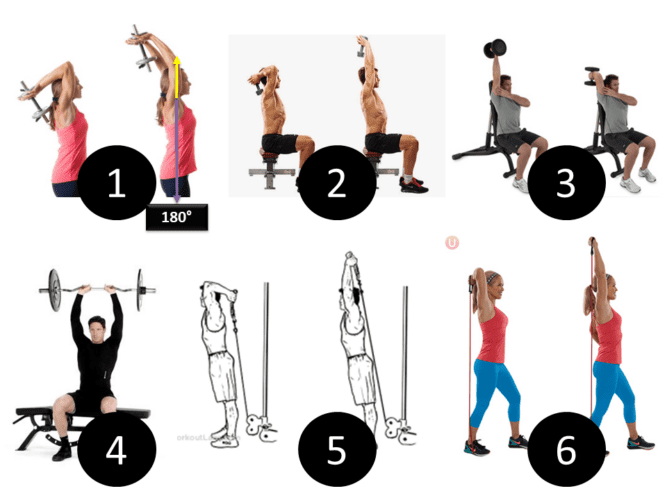
Elbow extensions with the shoulder flexed 180° can be done standing (1), seated (2) one-handed (3), barbell (4), low pulley (5) or by stepping on a rubber band (6).
If we perform them with one hand we can take advantage of the freedom of movement and perform an external rotation at the end of the movement (imagine that you have a branch taken by both hands and you want to break it) to increase the work of the lateral head.
Image 9 shows several best triceps exercises that provide a very similar stimulus to the previous ones, but slightly varying the angle of shoulder flexion.
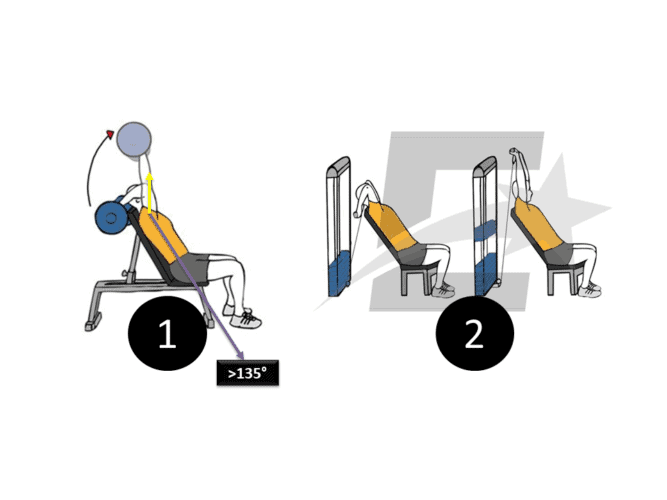
Overhead elbow extensions can be performed by leaning on a slightly inclined bench with free weights (1) or with a pulley or rubber bands (2), so the shoulder flexion that was previously 180° would now be slightly less.
But we must not incline it excessively to avoid entering group 2 of triceps exercises.
Triceps overhead extensions (anteroposterior loading)
Another way to vary the stimulus is that the force vector is anteroposterior (back to front) instead of axial (bottom to top) as in the previous exercises.
Several similar triceps exercises are grouped together in Figure 10.
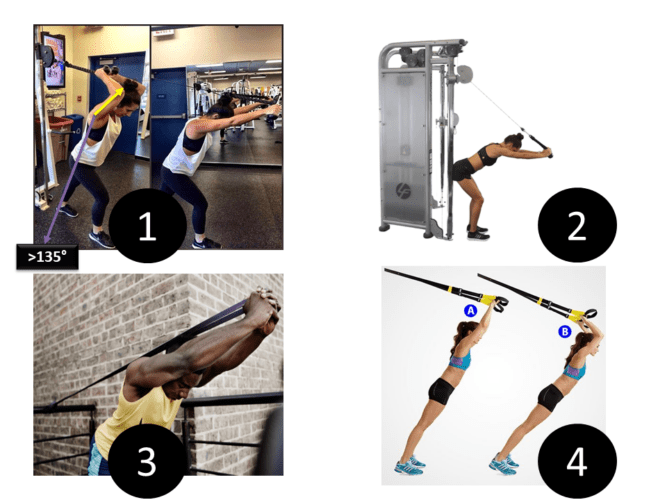
.
Overhead elbow extensions in high pulley (1) can be performed with less or more trunk tilt (2), but with the shoulder always in 180° flexion or close to it.
They can also be performed with rubber bands (3) or with your own body weight with TRX (4).
Group 2: Triceps exercises with partial shoulder flexion
- Shoulder flexion from 90° to 135° . This is a large shoulder flexion, but not maximal like the previous group of triceps exercises.
- In this position the long head is partially stretched.
- Emphasis on long head (somewhat less than group 1).
French Press
Several similar triceps exercises are grouped together in Figure 11.
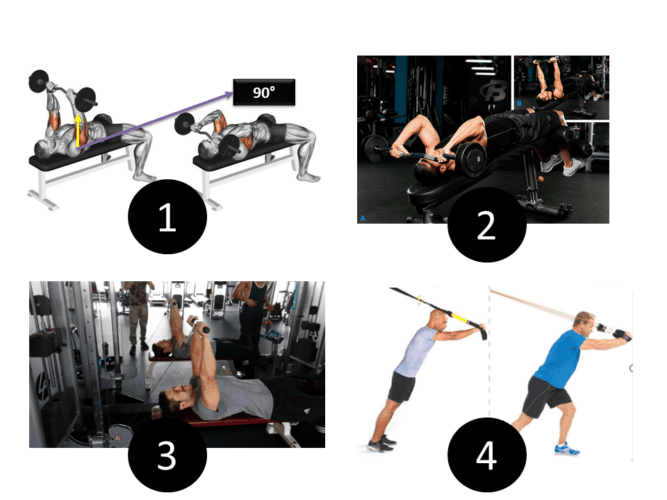
The French press can be performed with barbell (1) or with another free weight (dumbbell, disc, kettlebell…).
We can see how now the shoulder instead of being totally vertical (180°) as in group 1 of triceps exercises, is at 90° or slightly above.
If we choose a declined bench of about 15 (2) instead of the flat bench we slightly change the biomechanics of the exercise and we can give the triceps another different stimulus.
The same happens if instead of free weights, we work with a pulley (3), since now the weight does not depend on gravity (as in 1 and 2).
In the French press in pulley the vector of forces changes and does not go from bottom to top. It is a diagonal vector.
Another way is to perform it with the body weight in TRX with the shoulder elevation we are interested in (4) or with elastic bands.
Bench press with narrow grip
If for heavy lifting in the shoulder we have the military press, and for the legs we have the squat, for the triceps we have the bench press with narrow grip (image 12).
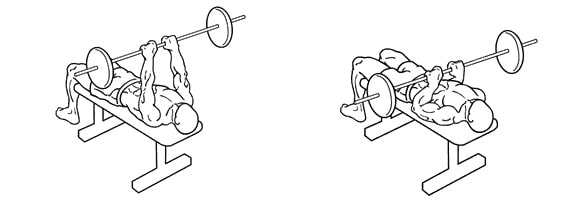
The exercise is executed like a bench press, but we close the grip to a biacromial (shoulder width) width, so that the pec becomes secondary and the triceps takes center stage.
Group 3: Triceps exercises without shoulder flexion
- No shoulder flexion (0°) or a slight flexion of less than 45°.
- In this position the long head is shortened.
- Emphasis on lateral (mainly) and medial head.
Triceps pulldown (push down)
Several similar triceps exercises are grouped together in Figure 13.
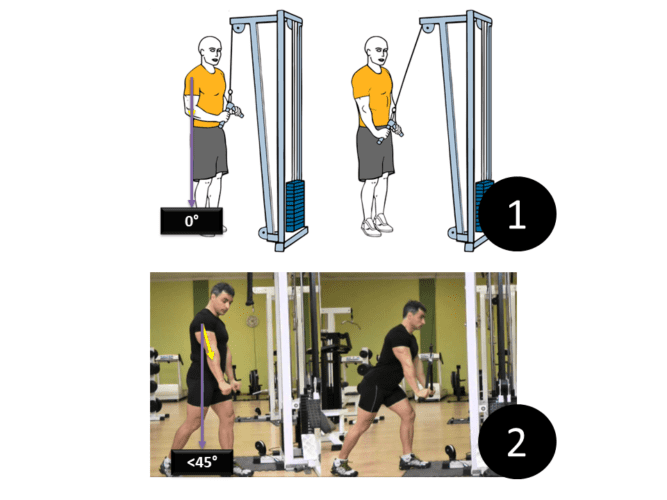
The push down can be performedwith the elbows close to the body (1) or with the elbows slightly in front of the body (2).
If you perform them with a rope, contract the triceps in the final phase and perform an external rotation (as if the rope were a branch and you wanted to break it in two).
Group 4: Triceps exercises with shoulder extension
- Slight shoulder extension. Elbows behind the body.
- In this position the long head is at maximum shortening.
- Emphasis on medial (mainly) and lateral head.
Triceps bottoms
Several similar triceps exercises are grouped together in Figure 14.
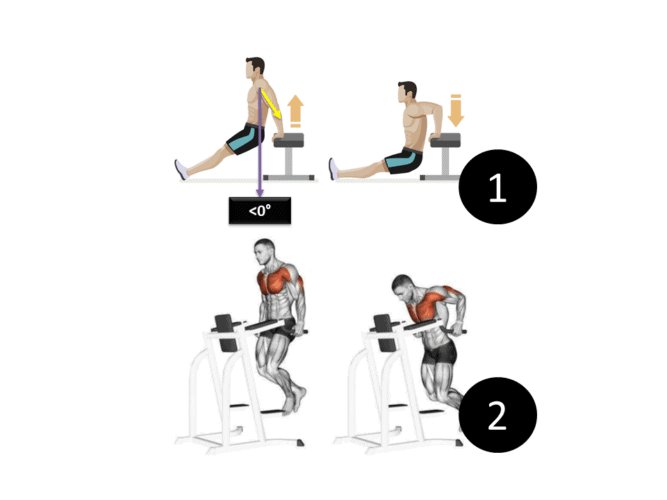
Triceps bottoms are an elbow extension that can be performed with hands resting on a bench (1) and feet on the floor, or on another bench to increase the load.
Or they can be performed on a parallel triceps bench press (2) in a closed grip, since opening the grip will involve the pectoralis to a greater extent.
Back kicks
Several similar triceps exercises are grouped together in Figure 15.
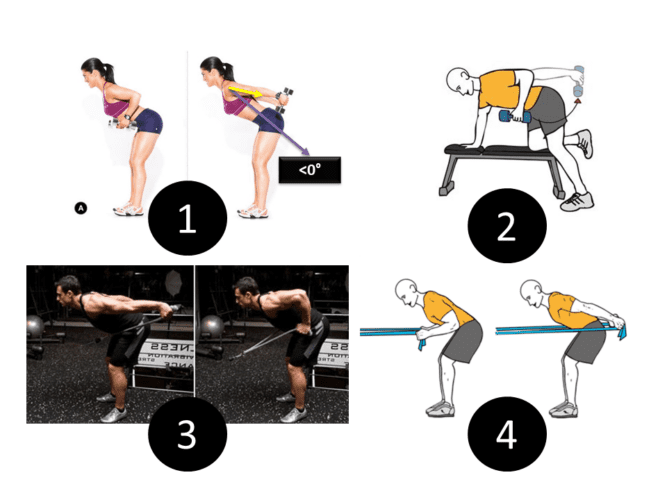
To achieve those negative degrees of shoulder flexion we can lean the trunk forward (about 60°) and perform elbow extension from there, which is known as back kicks (1).
You can use a bench as a support (2).
As we have already mentioned before, if we do it with free weights, the force vector will be from the bottom to the top due to gravity. To change this force vector we can use a pulley (3) or elastic bands (4).
Best exercises triceps
As we have seen, best triceps exercises are limited to elbow extension. We will not therefore speak of better or worse, because it is advisable to introduce exercises for triceps of the 4 groups exposed.
Instead, we recommend using exercises according to the load used and the number of repetitions performed.
High loads and medium-low repetitions
Although it does not have to be, at the beginning of the session we usually use the most demanding exercises and those in which we can move more kilos.
The bench press with narrow grip and parallel dips are the triceps exercises recommended to use high loads and medium-low repetitions.
Medium loads and medium reps
We can place these exercises in second place in the training session, after having performed one of the previous ones.
French press and overhead elbow extensions are the recommended triceps exercises to use medium loads and medium reps.
Medium-low loads and medium-high repetitions
They can be used third, after the above.
Back kicks with pulley are an ideal proposal for this section.
View this post on Instagram
Conclusions
The triceps brachii extends the elbow, and is composed of three heads: lateral, long and medial.
The long head is bi-articular so it depends on both the elbow and the shoulder while the lateral and medial heads depend only on the elbow.
This is why when we perform triceps exercises with full or partial shoulder flexion, the long head is activated more than the lateral and medial head.
To emphasize the lateral and medial head, it is advisable to use triceps exercises with the elbows close to the body or slightly in front of or behind the trunk.
It is also necessary to vary the grip (neutral, prone and supine) and the force vector to stimulate all the heads in their different zones.
You can arrange the best triceps exercises as follows in one session:
- first an exercise with higher load and fewer reps (close grip bench press or parallel dips).
- followed by an exercise with medium load and medium reps (French press or some variation of overhead elbow extension)
- and finally an exercise with low weight and medium-high repetitions such as back kicks with pulley.
Bibliographic references
- Ali, M. A., Sundaraj, K., Ahmad, R. B., Ahamed, N. U., Islam, M. A., & Sundaraj, S. (2015). Muscle Fatigue in the Three Heads of the Triceps Brachii during a Controlled Forceful Hand Grip Task with Full Elbow Extension Using Surface Electromyography. Journal of Human Kinetics, 46(1), 69-76.
- Ali, M. A., Sundaraj, K., Ahmad, R. B., Ahamed, U., Islam, M. A., & Sundaraj, S. (2014). Evaluation of triceps brachii muscle strength during grip force exercise through surface electromyography. Biomedical Research (Vol. 25).
- Alves, D., Matta, T., & Oliveira, L. (2018). Effect of shoulder position on triceps brachii heads activity in dumbbell elbow extension exercises. Journal of Sports Medicine and Physical Fitness, 58(9), 1247-1252.
- Davidson, A. W., & Rice, C. L. (2010). Effect of shoulder angle on the activation pattern of the elbow extensors during a submaximal isometric fatiguing contraction. Muscle and Nerve, 42(4), 514-521.
- Hussain, J., Sundaraj, K., Subramaniam, I. D., & Lam, C. K. (2020). Muscle Fatigue in the Three Heads of Triceps Brachii During Intensity and Speed Variations of Triceps Push-Down Exercise. Frontiers in Physiology, 11.
- Kholinne, E., Zulkarnain, R. F., Sun, Y. C., Lim, S. J., Chun, J. M., & Jeon, I. H. (2018). The different role of each head of the triceps brachii muscle in elbow extension. Acta Orthopaedica et Traumatologica Turcica, 52(3), 201-205.
- Landin, D., & Thompson, M. (2011). The shoulder extension function of the triceps brachii. Journal of Electromyography and Kinesiology, 21(1), 161-165.
- Landin, D., Thompson, M., & Jackson, M. (2018). Functions of the Triceps Brachii in Humans: A Review. Journal of Clinical Medicine Research, 10(4), 290-293.
- Madsen, M., Marx, R. G., Millett, P. J., Rodeo, S. A., Sperling, J. W., & Warren, R. F. (2006). Surgical anatomy of the triceps brachii tendon: Anatomical study and clinical correlation. American Journal of Sports Medicine, 34(11), 1839-1843.
- Murray, W. M., Buchanan, T. S., & Delp, S. L. (2000). The isometric functional capacity of muscles that cross the elbow. Journal of Biomechanics, 33(8), 943-952.
- Tiwana, M. S., & Bordoni, B. (2020). Anatomy, Shoulder and Upper Limb, Triceps Muscle. StatPearls.
